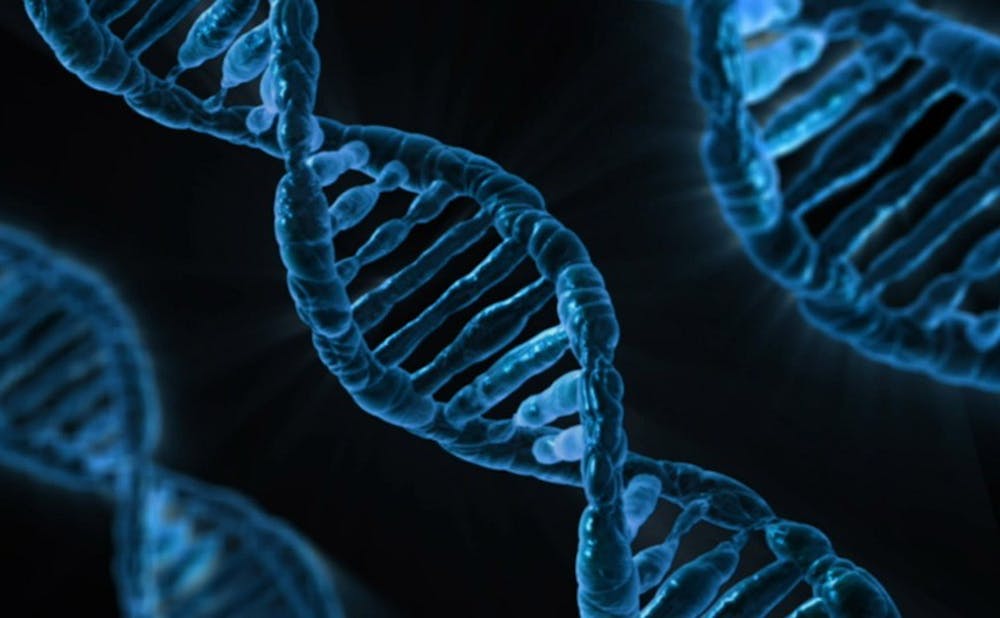A new study from Duke’s biochemistry department has explained why DNA—not RNA—became the signature blueprint of life.
Using new imaging technology, the researchers attempted to capture evidence of RNA molecules in the Hoogsteen conformation, a type of structure previously shown to help damaged DNA be repaired. Although DNA Hoogsteen base pairs have been shown to exist stably in nature, these new findings suggest that rather than switching into the Hoogsteen form, RNA base pairs simply melt and fall apart. The team’s work helps explain why DNA was favored over RNA to store the genetic code and also provides a new framework for studying the basis behind RNA structure, said Hashim Al-Hashimi, James B. Duke professor of biochemistry and chemistry.
“The cellular machinery has to have a way to distinguish between RNA and DNA [so that] DNA binding proteins bind DNA not RNA…[and] DNA is copied and RNA is translated, not the other way around,” Al-Hashimi wrote in an email. “Uncovering the differences between RNA and DNA is therefore critical for understanding how the cell distinguishes the two molecules.”
The researchers’ discovery helps explain why DNA-based genomes evolved as the main carrier of genetic information, given the widely accepted hypothesis that self-replicating RNA molecules from billions of years ago are thought to be the precursors of all life on Earth.
The structure of DNA is often compared to a spiral staircase, with two spiraling strands connected to each other through pairings between chemical bases which extend along each strand. This model—named after its discoverers James Watson and Francis Crick—is how most DNA behaves, explained Huiqing Zhou, first author of the study and a graduate student in the Al-Hashimi lab, in an email. In 1959, however, a scientist named Karst Hoogsteen found that some DNA base pairs are capable of adopting a unique geometry with one base rotated outward relative to the other, forming a new base pairing.
Zhou added that in 2011, her group showed that Hoogsteen base pairs exist transiently in DNA, lasting less than one millisecond and, at any time, comprise about one percent of an entire DNA molecule.
In their recent investigation, Zhou and her colleagues shifted gears by attempting to visualize Hoogsteen base pairs in double-stranded RNA, also called RNA duplexes. By doing so, Al-Hashimi explained, they hoped to test the robustness of the system originally used to visualize DNA Hoogsteen base pairs in 2011.
“It is extremely difficult to capture fleeting states that exist for a fraction of a second and in exceptionally low abundance—one has to basically build a lens that can process complex data into an image,” he wrote. “So we were always looking for controls—for sanity checks—and one way to do this [was] to examine what happens when working with a variant of the system. RNA was an obvious variant to DNA.”
Since previous researchers had found evidence of RNA Hoogsteen conformations outside of double-stranded RNA, the Al-Hashimi lab expected their study to reveal similar conformations within double-stranded RNA.
Instead, however, they were shocked to find no evidence of such a structure, Al-Hashimi wrote.
“Initially, we had no reason to think that Hoogsteen base pairs could not form in RNA duplexes,” he explained. “After all, if you look at the DNA and RNA double helices, they differ in rather subtle ways. In fact certain DNA sequences can look a little like RNA double helices.”
Because it was possible that RNA Hoogsteen base pairs were shifting too quickly to be captured, the team began to place a specific chemical group on specific RNA bases, a step which they knew could force Hoogsteen bases to form, Al-Hashimi wrote.
Rather than forming Hoogsteen base pairs, however, the modified molecules instead fell apart, unable to accommodate the individual Hoogsteen bases.
In their publication, the investigators suggested that the natural, compressed structure of the RNA duplex may play a role in its inability to maintain Hoogsteen base pairs. This aspect of RNA is something that Al-Hashimi said he hopes to explore in the future.
“I do not think we fully understand why the RNA double helix does, in fact, differ in structure from that of DNA,” he wrote. “So I think the different forces that stabilize the two remain to be understood. We would like to develop methods to visualize and map Hoogsteen base pairs genome-wide and to better understand their role in gene expression and genome stability maintenance.”
In a DNA genome, Hoogsteen base pairs can serve as signals to repair proteins. Zhou explained, however, that repairs within a double-stranded RNA genome would be impossible to fix since they do not appear to accommodate the Hoogsteen conformation in a stable way.
Al-Hashimi said these discoveries further explain why DNA evolved as life’s main genetic toolkit over RNA.
“There is great interest to specifically target DNA [without touching] RNA and vice versa using drugs, and, therefore, knowing their dynamic differences could be important,” he wrote. “For example, a drug that binds [only] Hoogsteen base pairs is unlikely to bind RNA. But I think there is also a wonderful connection to the evolution of these molecules and why DNA became the carrier of genetic information in higher order organisms. The main reason is often attributed to the greater chemical stability of DNA; however, it may be that we have overlooked other differences.”
Get The Chronicle straight to your inbox
Signup for our weekly newsletter. Cancel at any time.

